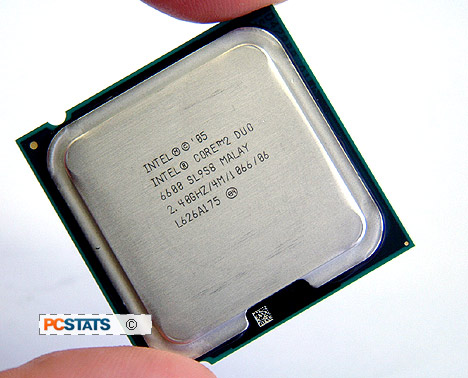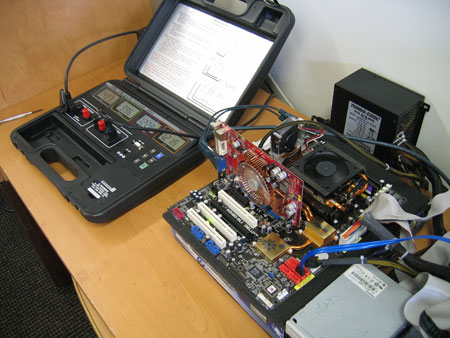 Gone are the days when performance benchmarks
settled all Intel vs. AMD processor debates.
Gone are the days when performance benchmarks
settled all Intel vs. AMD processor debates.
The tone of the desktop computing world has palpably shifting towards power
conservation, and even individual computer users are starting to wonder "just
how much power is this going to take to get me there?"
Perhaps it's only when we
consider the 24x7x365 electrical operating cost of a computer that any small power reduction
musters any significance, but there it is. In a sense, what's happening
now parallels the transition to from loud computers to the silent PC
esthetic.
Before hot-running computer processors went quiet, enthusiasts' attempts to
reduce the PC noise were exceptions to the rule, rather than the norm.
An entire industry now thrives on selling quiet computer hardware, could the
same hold true for energy efficient desktop processors that don't sacrifice
performance?
I think we're all still finding our feet on energy
efficient components, but it's certainly a new aspect PCSTATS will be considering as
we mull over the benchmark results for the Intel Core 2 Duo E6600 processor later
in this review.
ow, let's get on with the total system power draw tests.
Total Power Consumption Tests
 The price of
energy is increasing world wide, and any reduction in the amount of power a CPU
requires is welcome. Wading through the technical numbers that Intel and AMD
provide can be confusing because each company reports values in slightly
different ways.
The price of
energy is increasing world wide, and any reduction in the amount of power a CPU
requires is welcome. Wading through the technical numbers that Intel and AMD
provide can be confusing because each company reports values in slightly
different ways.
On paper AMD appears to consume more power since its values are higher,
however AMD lists its maximum power usage while Intel posts
typical. Obviously the two are not comparable and to
find out which actually consumes more power, we decided to test things
out.
Representing Intel will be an Intel Core 2 Duo E6600, Pentium D 840, Pentium 4 540 and Pentium D 940 processor. Standing in for
AMD are the socket AM2 Athlon64 FX-62, Athlon64 X2 5000+, Athlon64 X2 4800+ and socket 939 Athlon64 4000+ and Athlon64 FX-60 processors.
The test
specs for each system stayed as constant as possible: Akasa PowerPlus AK-P550FF power supply, Western Digital 74GB Raptor hard drive, an 8x Gigabyte
DVD-/+RW drive and a MSI NX6600GT-TD128E videocard. Please note that EIST is disabled
for these tests, with EIST enabled, total system power draw will be even
less that what is reported. The Extech Power Analyzer is located between
the mains 120AC supply and the PC power supply.
To
simulate single-core load, the Prime95's Small FFT test was run, and two
instances launched for dual core loading. Total system power consumption was
read with a Extech Power Analyzer Datalogger (model 380803) for both CPU loaded
and CPU idle states. Please keep in mind that these values are measuring an entire system while the processor is running under
computational load or idle.
How does
the Intel Core 2 Duo E6600 impact total system power draw? Let's have a
look....
E6600 Power Load Tests
The tables have turned completely, Intel's Pentium 4/D processors draw a lot of
power, while the new Core 2 Duo line is very easy on the energy consumption.
This is not surprising since the Pentium
4/D is clocked 95-130W and the Core 2 Duo at 65W. Still it's important
to note that even a computer based on a 65W processor consumes more than 65W.
| Total System Idle Power
Draw |
| Processor |
Total System Power Draw |
| Intel Pentium 4
540 |
   150 Watts 150 Watts |
| Intel Pentium D
840 |
   165 Watts 165 Watts |
| Intel Pentium D
940 |
   168 Watts 168 Watts |
| AMD Sempron
3600+ |
   120 Watts 120 Watts |
| AMD Athlon64
4000+ |
   163 Watts 163 Watts |
| AMD Athlon64
FX-60 |
   127 Watts 127 Watts |
| AMD Athlon64 X2 4800+ |
   143 Watts 143 Watts |
| AMD Athlon64 X2
5000+ |
   156 Watts 156 Watts |
| AMD Athlon64
FX-62 |
   168 Watts 168 Watts |
 Intel Core 2 Duo E6600 Intel Core 2 Duo E6600 |
   117 Watts 117 Watts |
The Intel Core 2 Duo E6600 is the most efficient
desktop processor PCSTATS has tested to date. It consumes just a bit less power than the budget single-core
AMD Sempron 3600+ (120W)! The heavy hitters are the Pentium D 940
at 168W and the AMD Athlon64 FX-62 at 168W.
Next up we'll look at power consumption with the
processors under single and dual core loads (where applicable). This illustrates
the effect that multicore CPU loading can have on a processors power
efficiency.
